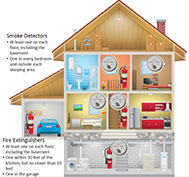EMERGENCY RESPONSE WEB APP
Take action to prevent a fire from occurring in your home
Properly locate fire extinguishers and smoke detectors and develop an evacuation plan
Protect yourself and your family during a fire
Help your family recover emotionally, inspect the damage, and start the rebuilding process

Many fire departments will take old fire extinguishers
TIP: Have family members practice with old fire extinguishers outside and without a fire. Or, but an extra fire extinguisher for this purpose
DO NOT use a household fire extinguisher on a grease fire (unless it is a class K fire)

Check for loose power lines, broken or damaged gas lines, cracks in the foundation, or missing support beams